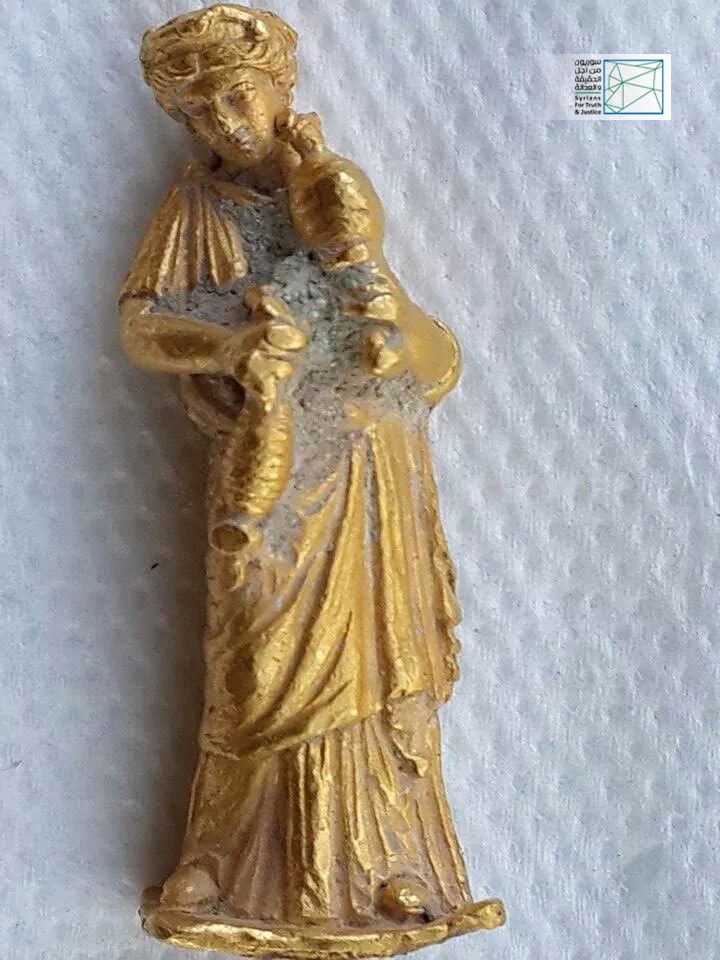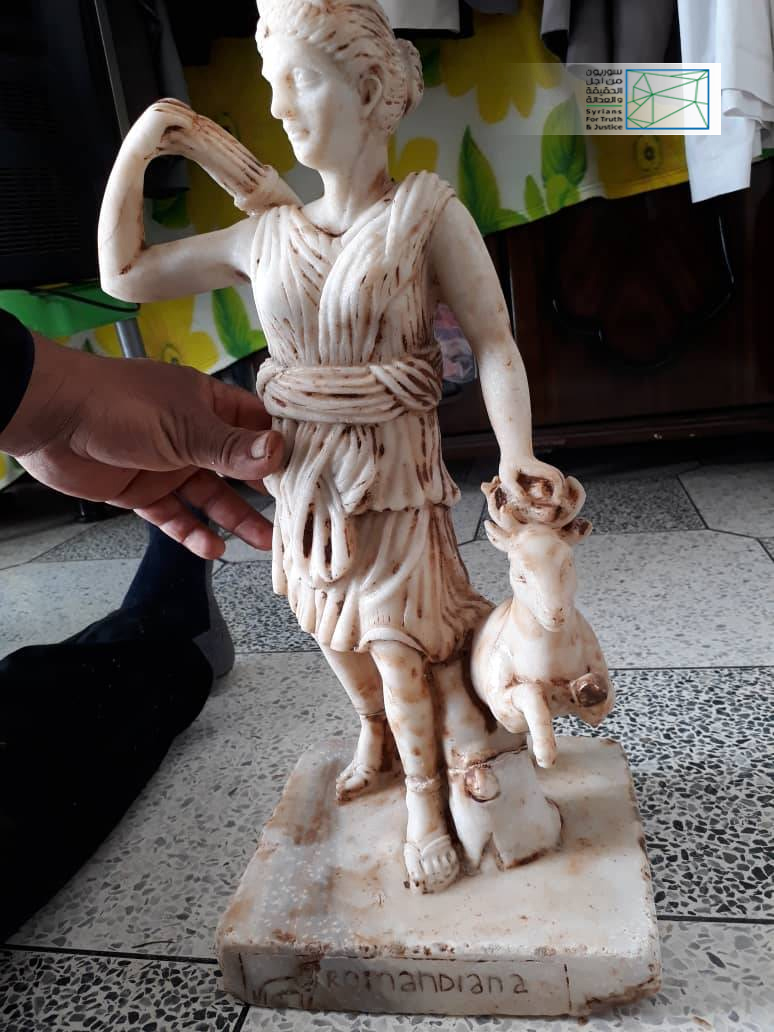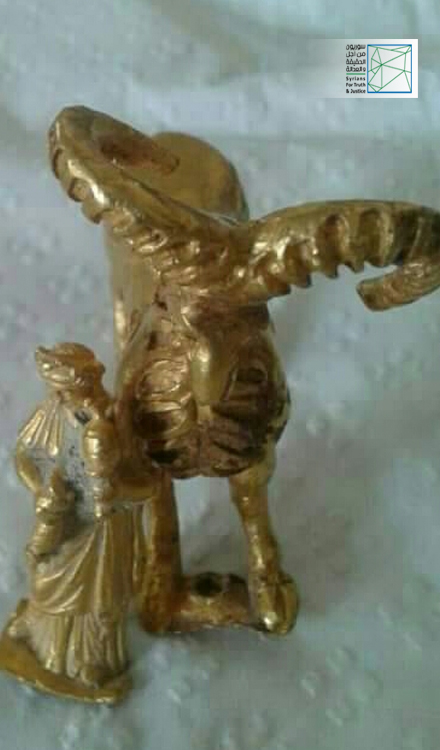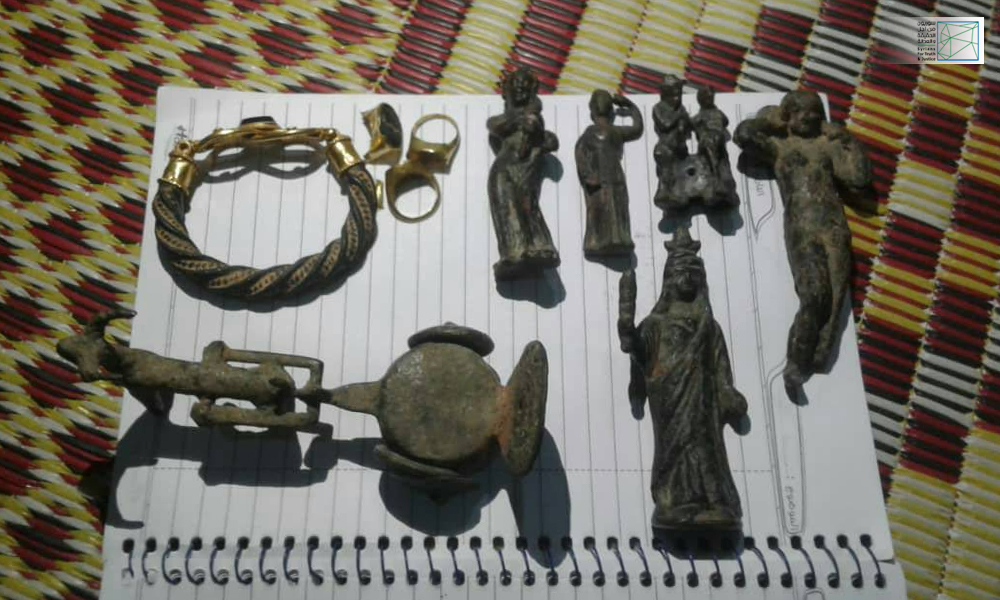The scale of random illegal excavations increased recently in many areas in the province of Hama. Some civilians formed their own groups to dig for artifacts. The excavation groups started in parts particularly in the west and north of Hama because they are well-known for many historical sites such as the citadel of Apamea /Qalaat al-Madiq[1], Tell Qaraqur, among others. The findings looted are smuggled out of Syria and then sold. An STJ's field researcher said the workers dig the archaeological cemeteries around the citadel of Apamea[2] and its exterior walls.
More than 100 unauthorized groups excavate randomly in rural Hama, especially in the citadel of Apamea. Although the residents have appealed to stop such aggressions on the Syrian cultural heritage, many persons are still hunting ruins to sell them for peanuts and export them abroad. The phenomenon has spread in the full view of the armed opposition groups.[3]
This isn’t the first time such actions ocuure in armed opposition groups-controlled areas. In August 2018, a group of about 500 persons, hunted the historical sites in Kafriya and al-Fu'ah cities after obtaining permission from the armed groups there including Hayat Tahrir al-Sham (HTS), Ahrar al-Sham al-Islamiyya, and Suqour al-Sham[4].
The UNESCO's 2017 report announced it received reports and images from the UN's Institute for Training and Research (UNITAR) and the UN's Operational Satellite Applications Programme (UNOSAT) confirming the destruction of one of Palmyra's most prominent cultural symbolic namely the Tetrapylon as well as the exterior facade of the Roman Theatre. The report also condemned the destruction of Syria's historical sites[5].
In another report[6] published in 2014, the UNESCO said "Excavated archaeological objects of cultural significance make a lucrative trade for unscrupulous dealers operating both locally and abroad. There are reports that Syrian cultural objects are being offered to the international art market. Recent evidence of illegal systematic excavations and looting of the Apamea archaeological site in the Syrian province of Hama".
"The protection of cultural property during armed conflict is based on the principle that damage to the cultural property of any people means, in the words of the 1954 Hague Convention, damage to the cultural heritage of all mankind.
Cultural property is protected during war in two ways. Because it is normally civilian in nature, the general provisions of humanitarian law protecting civilian property apply.
Specific protection recognizing the cultural heritage of every people is enshrined in the 1954 Hague Convention for the protection of cultural property during armed conflict, which was complemented by the 1977 Additional Protocols, and has become part of customary international law."[7]
- Random excavations surge in the citadel of Apamea
Since early 2018, the random excavations have vastly increased in the west parts of Hama amidst the absence of inspection by the armed groups. Ibrahim al-Hamza, a resident from Qalaat al-Madiq and a participant in an excavation group, reported to STJ the ways they use in hunting, revealing where and how the objects are exported to.
"We are all aware of the cultural value of these findings. They are part of Syria's heritage. However, due to several factors, including the rampant of unemployment amongst the youths, many engaged in such a business to provide for their families. There are over 100 illegal excavation groups, about three or eight participants in each, working in the north and the west areas in Hama. Hunting archaeological objects is divided into two parts: first, if the excavation is in archaeological sites, then, we need to pay to no one. Besides, our job is easier as we do not dig too deep holes. Second, if the excavation is in areas owned by ordinary people, then we have to take the permission of the landowner who shares some of the profits afterwards. However, an expert is initially brought to confirm us that there might be some precious antiquities beneath.”


Some archaeological objects taken from the citadel of Apamea in the west of Hama during the excavations that started in early 2018 up to October 2018.
Since early 2018, many excavations have taken place in areas around the citadel of Apamea and its external walls where the Syrian army is stationed. Usually, diggings are in specific times and circumstances so that fighters of the Syrian army won't discover the clandestine work, al-Hamza said.
"We have also excavated in other sites, including the historical site of Hortah in Shashabo Mountain, and Tell Qaraqur in Sahl al-Ghab area. The findings we get were only coins and utensils made of copper and clay, which were not of great worth. However, we sometime found valuable statues and golden coins, mostly dating back to the Roman era.
As for the equipment used for digging, we use smooth iron bars, about one to four meters long, called by the locals ‘al-Jasos’. We also use traditional digging tools such as the spade, in addition to a special detector to locate the antiquities. It was initially a device to detect landmines but was developed to be help us locate treasures. It is sold for $500, and is smuggled from one of the neighboring countries."
The findings are sold to well-known local dealers who export them abroad. In general, if the findings date back to the Islamic periods, they are sold to Arab dealers, but if they date back to very ancient periods, then they are sold to foreigner dealers, al-Hamza added.
"The local and foreigner dealers reap the rewards unlike us, the hunters, who have no choice but to sell them the findings for cheap prices. I feel pleasant when my group finds archaeological stuff and sell them, but at the same time I feel sad as I know that we misuse our country's precious cultural property unwillingly. Poverty and unemployment have prompted many young men to take up such a business", al-Hamza said.
Shahoud al-Jadou', a media activist in Kafr Zita, testified that the phenomenon of random archaeological excavations in Hama has started prior to the onset of the crisis in 2011, but it spread vastly over the three last years. This is an aggression on the country's culture heritage, which is sold by some mean-spirited persons in the black market for peanuts.
"Before the onset of war, every found item was been confiscated by the regime forces. But with the start of the conflict, some persons in armed opposition groups-controlled areas started hunting amidst the absence of inspection. However, this act is wholly unacceptable, and many civilians oppose it and do their best to fight it. Yet, excavation has not stopped. The armed groups must enforce laws criminalizing the hunters who excavate illegally. The findings must be recollected from the hunters and preserved to be the country's culture heritage in the future. The opposition must establish an official archaeological authority tasked with putting the findings in the right place far from the dealers who care only about money without taking into consideration the implications."
- Excavation is a source of income in rural Hama
Hozayfa Mohammed, an alias, is from Sahl al-Ghab in the west of Hama. He is married with three kids. He quit teaching in early 2013 due to difficult security circumstances and his six-month term imprisonment in Damascus. In mid-2015, he started working in an excavation group to meet the ends of his family.
He testified:
"After I quit teaching, a friend of mine offered me to work with the excavation group he works with. I accepted and started working in June 2015. The citadel of Apamea was our starting point. We used to dig the lower parts of the citadel overnight so that the Syrian army do not spot us. We worked there only for few days. After that, we moved to hunt in Tell Qaraqur, which is a historical site in the north of Sahl al-Ghab. The guy who ran the group, equipped us with all the needed tools. Our search there was overnight as well because the residents did not allow excavations. We took turns in digging and lifting up dirt. We were accompanied by an expert to value the findings. We hunted for two weeks in Tell Qaraqur without finding any trophies. Tell Qaraqur was a high hill and the expert told us that the valuable objects lie within the hill deep in the ground. It was an extremely difficult work."
Upon finishing excavations in Tell Qaraqur, Mohammed and his friends decided to hunt somewhere else. They headed to Tell Qalidin in Sahl al-Ghab area in the west of Hama. Only hours after digging, they found an entrance to a Roman Church. Next to the entrance was a mosaic portrait, which was partially damaged due to previous diggings, he alleged.
"We have hunted in several areas, including the citadel of Apamea, Tell Qaraqur, Tell Qalidin, the al-Kharabt area in the west of Idlib, and in the al-Bara area. Unfortunately, we did not find valuable artifacts such as golden objects, statues, or royal tombs. Therefore, we moved to another kind of work, which is searching for signs that locate hidden treasures. Some of the signs were the shape of animals such as scorpion, tortoise, and camel, other signs were of geometric shapes. However, we found none of these signs in Hama. Once we found the sign of a scorpion in the Kurds Mountain in Lattakia, but we did not examine the sign as an armed group intervened and prevented us from completing our work on the pretext that it was a military zone.
During my work in this field, I noticed that almost every region in Hama contains a historical site but the majority of them have been looted before, which means that earlier excavations had taken place there. In short, the youths favor archaeological excavation, which becomes a common business nowadays. Unemployment and the chaos play a significant role in spreading this phenomenon. The security forces of the armed groups do not mind excavation, nor they adapt relevant laws to prohibit it".
Khalid al-Haj Abbas, an archaeological expert in the west of Hama, explained why there are too many ancient antiquities in Hama, and what are the most precious findings he examined during his work in providing expertise to the dealers and hunters. He said the biggest collection excavated were statues and coins.
"Historically saying, Hama has a big stash of antiquities because many kings and sultans from ancient times lived there as it has all basic necessities of life, including fertile agricultural land, the Orontes river, and the perfect soil for building citadels and forts. Therefore, hundreds of goods were removed out from Hama's historical sites over the past two years. Some of them were of a historical and tangible values. The statues fall into two categories. Some of them were made to resemble the gods and goddesses that people worshiped at the time. Others resembled a king or a prince, whom images were depicted so that they would become immortal. The statues were made of stone or clay and were put in the corners of important buildings like theaters, temples, baths, and palaces, among others. The Romans who ruled the area were famous for theses statues."


Some archaeological goods found in the citadel of Apamea in west Hama during excavations that started early 2018 up to October. Photo credit: STJ
Abbas said the statue will have a historical value if it was an image of a king or a prince, or if it was made in the Roman or the Greek eras.
Concerning the coins, they fall into two categories. Islamic coins and non-Islamic coins. However, both are similar because they are made of gold, copper, and silver.
"The coins are of great importance since they were released by kings and princes to be circulated by people just as it is the case now. The value of the coins lies in their quality, the historical period they were used in, the type of material they were manufactured from, and the portraits on them. The number of the coins found is also matters. Sometimes, hundreds of coins discovered in one place, such as in a box or a pottery. This is often the case when it belongs to a king or a wealthy person. We notice that some of the coins that were found in Hama date back to the Islamic periods such as the Umayyad period. But the majority of them date back to the Roman era. Finally, I am sure that there are thousands of coins still buried in areas in Hama, especially in the citadel of Apamea, Tell Qarqour, Hortah, Umm Nir village, among others."
- Futile pleas to prevent random excavations in Hama
Ibrahim al-Saleh, head of the local council in Qalaat al-Madiq in Hama, told STJ that random excavation has been chugging along. It is a bad unacceptable phenomenon, and the local council took action to end it but the chaos and the absence of protecting ruins-related authorities have contributed to the rise in the number of unauthorized excavation groups that work freely without the fear of being held accountable.
"Random hunting for archaeological objects have become a popular issue that is practiced without fear of prosecution. Excavation work takes place across Hama in general and in the citadel of Apamea in particular as there are many historical sites around it but they are controlled by the Syrian army. We, the staff at the local council, take action to prevent such a business, but the current situation imposes non-inspection of it. Besides we did not manage to stop excavation completely because of the numerous groups operating in the city. All we did was to prevent the plunder of big pieces such as columns, among others. We are still fighting the illicit excavation. Moreover, we concluded an agreement with Hama's Free Council, which is affiliated to the Syrian Interim Government, as well as with the city-based courts to prosecute any person who smuggles archaeological stones or columns outside the city. Many hunters were held accountable."
[1] The Syrian regular forces control only the citadel in Qalaat al-Madiq, whereas the armed opposition groups control the city of Qalaat al-Madiq.
[2] "Apamea was founded in 301 B.C., Apamea was one of the most important cities of North Syria in the Seleucid era. During the beginning of the Roman era, Apamea counted some 117.000 inhabitants. Due to its strategic position at that time, it played both a prominent military and commercial role.
The Apamea site is considered one of the most affected sites as a result of ongoing illegal excavations, which are centered on the eastern, northeastern, and western regions of the city.
Armed gangs have systematically carried out illegal excavations, using bulldozers and occasionally using electronic machines to search for metals, targeting mosaics. For more information, please read "Apamea: Observatory of Syrian Heritage", the United Nations Educational, Scientific and Cultural Organization (UNESCO), https://en.unesco.org/syrian-observatory/news/%D8%A3%D9%81%D8%A7%D9%85%D9%8A%D8%A7
[3] Several armed groups control the north and west parts of Hama. The most prominent of these groups are Jaysh al-Izza and Jaysh al-Nasr (the Army of Victory).
[4] "Excavations in Kafriya and al-Fu'ah Following Rebels’ Control", STJ, September 19, 2018, https://www.stj-sy.org/en/view/760
[5] "UNESCO condemns the Destruction of Syria's Historical Sites", UN News, January 27, 2018, https://news.un.org/en/story/2017/01/269092
[6] "Systematic excavations of archaeological sites", the UNESCO, October 9, 2018, http://www.unesco.org/new/ar/safeguarding-syrian-cultural-heritage/situation-in-syria/movable-heritage/archaeological-sites/.
[7] "Protection of Cultural Property in the Event of Armed Conflict", the International Committee of the Red Cross (ICRC), October 27, 2010, https://www.icrc.org/en/document/protection-cultural-property-armed-conflict.

